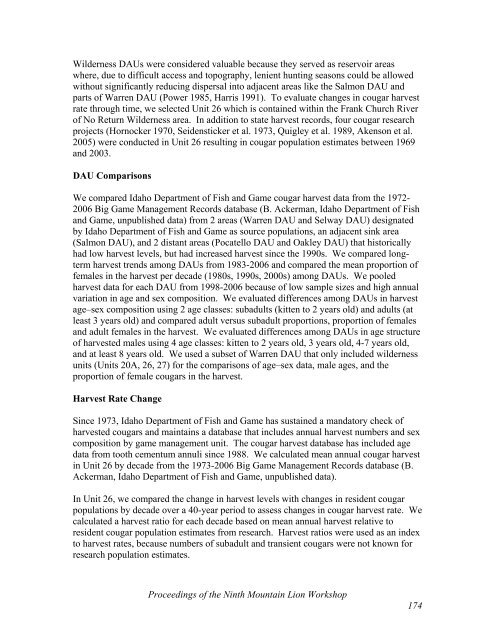Proceedings of the Ninth Mountain Lion Workshop - Carnivore ...
Proceedings of the Ninth Mountain Lion Workshop - Carnivore ...
Proceedings of the Ninth Mountain Lion Workshop - Carnivore ...
You also want an ePaper? Increase the reach of your titles
YUMPU automatically turns print PDFs into web optimized ePapers that Google loves.
Wilderness DAUs were considered valuable because <strong>the</strong>y served as reservoir areas<br />
where, due to difficult access and topography, lenient hunting seasons could be allowed<br />
without significantly reducing dispersal into adjacent areas like <strong>the</strong> Salmon DAU and<br />
parts <strong>of</strong> Warren DAU (Power 1985, Harris 1991). To evaluate changes in cougar harvest<br />
rate through time, we selected Unit 26 which is contained within <strong>the</strong> Frank Church River<br />
<strong>of</strong> No Return Wilderness area. In addition to state harvest records, four cougar research<br />
projects (Hornocker 1970, Seidensticker et al. 1973, Quigley et al. 1989, Akenson et al.<br />
2005) were conducted in Unit 26 resulting in cougar population estimates between 1969<br />
and 2003.<br />
DAU Comparisons<br />
We compared Idaho Department <strong>of</strong> Fish and Game cougar harvest data from <strong>the</strong> 1972-<br />
2006 Big Game Management Records database (B. Ackerman, Idaho Department <strong>of</strong> Fish<br />
and Game, unpublished data) from 2 areas (Warren DAU and Selway DAU) designated<br />
by Idaho Department <strong>of</strong> Fish and Game as source populations, an adjacent sink area<br />
(Salmon DAU), and 2 distant areas (Pocatello DAU and Oakley DAU) that historically<br />
had low harvest levels, but had increased harvest since <strong>the</strong> 1990s. We compared longterm<br />
harvest trends among DAUs from 1983-2006 and compared <strong>the</strong> mean proportion <strong>of</strong><br />
females in <strong>the</strong> harvest per decade (1980s, 1990s, 2000s) among DAUs. We pooled<br />
harvest data for each DAU from 1998-2006 because <strong>of</strong> low sample sizes and high annual<br />
variation in age and sex composition. We evaluated differences among DAUs in harvest<br />
age–sex composition using 2 age classes: subadults (kitten to 2 years old) and adults (at<br />
least 3 years old) and compared adult versus subadult proportions, proportion <strong>of</strong> females<br />
and adult females in <strong>the</strong> harvest. We evaluated differences among DAUs in age structure<br />
<strong>of</strong> harvested males using 4 age classes: kitten to 2 years old, 3 years old, 4-7 years old,<br />
and at least 8 years old. We used a subset <strong>of</strong> Warren DAU that only included wilderness<br />
units (Units 20A, 26, 27) for <strong>the</strong> comparisons <strong>of</strong> age–sex data, male ages, and <strong>the</strong><br />
proportion <strong>of</strong> female cougars in <strong>the</strong> harvest.<br />
Harvest Rate Change<br />
Since 1973, Idaho Department <strong>of</strong> Fish and Game has sustained a mandatory check <strong>of</strong><br />
harvested cougars and maintains a database that includes annual harvest numbers and sex<br />
composition by game management unit. The cougar harvest database has included age<br />
data from tooth cementum annuli since 1988. We calculated mean annual cougar harvest<br />
in Unit 26 by decade from <strong>the</strong> 1973-2006 Big Game Management Records database (B.<br />
Ackerman, Idaho Department <strong>of</strong> Fish and Game, unpublished data).<br />
In Unit 26, we compared <strong>the</strong> change in harvest levels with changes in resident cougar<br />
populations by decade over a 40-year period to assess changes in cougar harvest rate. We<br />
calculated a harvest ratio for each decade based on mean annual harvest relative to<br />
resident cougar population estimates from research. Harvest ratios were used as an index<br />
to harvest rates, because numbers <strong>of</strong> subadult and transient cougars were not known for<br />
research population estimates.<br />
<strong>Proceedings</strong> <strong>of</strong> <strong>the</strong> <strong>Ninth</strong> <strong>Mountain</strong> <strong>Lion</strong> <strong>Workshop</strong><br />
174
















